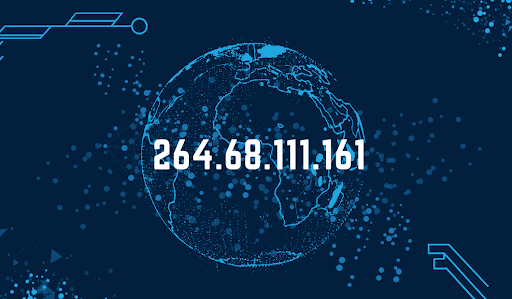The Mystery Behind 264.68.111.161: A Deep Dive Into the Cybersecurity Enigma
If you’ve come across 264.68.111.161, you’re likely intrigued by its mysterious presence on logs, forums, or cybersecurity discussions. 264.68.111.161 isn’t just another sequence of numbers; it represents a curious anomaly that sparks intense debate among digital analysts and cybersecurity experts. From being labeled an invalid IP address to spawning discussions around IP spoofing, cyber myths, and malicious intent, this entry is far from ordinary.
Let’s dig deep into the origin, misconceptions, real-world impacts, and cybersecurity implications surrounding this digital phantom.
What Is 264.68.111.161? Understanding the Basics
To start, it’s important to point out that 264.68.111.161 is not a valid IPv4 address. In the IPv4 system, each segment of an IP (called an octet) ranges from 0 to 255. That makes the first octet “264” an immediate red flag — it exceeds the upper limit, rendering this IP technically non-existent or malformed.
Despite this, many have reported encountering this address in:
- Server logs
- Firewall alerts
- Traffic monitoring tools
This anomaly has given rise to a number of theories and interpretations, from simple software glitches to far more sinister explanations involving spoofing or deliberate tampering.
Why Does 264.68.111.161 Appear in Logs?
When an invalid IP like 264.68.111.161 shows up in logs, it usually stems from:
- Log parsing errors – Software might misread or mishandle corrupted data.
- IP spoofing – Malicious actors may fake the source IP address to mask their identity.
- Firewall misconfigurations – Poorly configured systems might not properly validate inputs.
- DNS hijacking or poisoning – Attackers could reroute requests or tamper with domain name resolutions.
The strange appearance of such an IP address usually implies intentional deception or system malfunction, both of which deserve immediate attention from IT administrators.
The Cybersecurity Implications of 264.68.111.161
The existence of a bogus IP like 264.68.111.161 in any network system is not just an anomaly — it’s a cybersecurity concern. Here’s why:
- Evasion of Tracking Mechanisms
Cybercriminals often manipulate IPs to hide their real location or trick tracing systems. An invalid address like this could be part of that tactic. - Security Policy Violations
Firewalls and routers rely on valid address rules to permit or deny access. Anomalies in these rules may expose vulnerabilities if they mishandle invalid input. - Phantom Threats
These are entries that look like threats but don’t have a real source. They cause alert fatigue and waste resources, especially in automated monitoring environments. - Backdoor Testing or Reconnaissance
Threat actors might use such IPs to test system defenses, observe reactions, or prepare for more targeted attacks later.
Digital Myths Surrounding 264.68.111.161
In online forums, Reddit threads, and hacker communities, 264.68.111.161 has become something of a digital urban legend. Here are some of the more popular myths:
- “The Ghost IP” Theory
Suggests that 264.68.111.161 is part of a government surveillance tool that intentionally uses invalid IPs to avoid detection. - “The AI Artifact” Theory
Some believe this IP is generated by machine learning systems gone awry, particularly in training data used for botnet detection. - “The Signal” Theory
This one claims the IP is a marker or identifier used between hackers to signal compromised systems.
While these are speculative and largely unsupported by evidence, they underscore how mysterious and unsettling this rogue IP address has become in the cyber world.
How to Respond If You See 264.68.111.161 in Your Logs
If your system flags 264.68.111.161, you should take it seriously. Here’s how to respond:
- Validate Your Logs
Confirm that the logs aren’t being misinterpreted or corrupted by your parsing tools. - Run a Full Security Audit
Check for any unusual activity before and after the appearance of the IP. Look for spikes in CPU usage, unauthorized access, or strange patterns. - Update Firewall and IDS Rules
Ensure that your intrusion detection systems and firewalls are capable of filtering out malformed addresses. - Check DNS and Proxy Settings
A compromised DNS or misconfigured proxy could be allowing traffic manipulation that generates such anomalies. - Report the Incident
Inform your cybersecurity team or threat intelligence network. Sharing this data could help others defend against similar events.
Why IP Spoofing Still Works in 2025
Despite advancements in cybersecurity, IP spoofing remains a surprisingly effective tactic. Since spoofing involves faking the source IP in packet headers, most standard verification systems — unless specially configured — don’t catch it in transit.
An invalid IP like 264.68.111.161 may be used in Denial of Service (DoS) attacks, man-in-the-middle attacks, or to overload log systems with junk data, making real threats harder to identify.
How Can Invalid IPs Bypass Modern Defenses?
Modern security systems rely on both software-based filtering and hardware-level enforcement. However, attackers are getting smarter. Here’s how they bypass protections:
- Using malformed packets that avoid detection rules
- Injecting data directly into logs through log4j-style exploits
- Confusing systems that lack proper input validation or rate-limiting
The use of an invalid IP address such as 264.68.111.161 may be a deliberate tactic to exploit such vulnerabilities.
Future Risks and the Rise of Invalid IP Exploitation
As more systems rely on automated detection tools and AI-assisted security, there’s a growing risk that anomalies like 264.68.111.161 will either be overlooked or misclassified.
- False positives will increase, leading to resource drains
- Legitimate alerts may be drowned out, allowing real breaches to go undetected
- Machine learning models may be tricked by introducing deliberately malformed inputs
Addressing this will require smarter AI models, better training datasets, and continuous human oversight.
Conclusion: Treat 264.68.111.161 as a Warning Sign
Whether it’s a glitch, spoof, or something more insidious, 264.68.111.161 is a sign that your system deserves a closer look. It’s a reminder that cybersecurity is not just about blocking known threats, but also being alert to unusual patterns, inconsistencies, and signals of manipulation.
In the modern age of cyber warfare, anomalies are no longer innocent mistakes — they are potential breadcrumbs of larger threats. Be proactive, stay updated, and keep your systems locked down.
If you ever come across 264.68.111.161 in your systems, treat it not just as a number — but a clue.
FAQs About 264.68.111.161
Q1: What is 264.68.111.161?
A: 264.68.111.161 is an invalid IPv4 address. It appears suspicious in server logs and cybersecurity tools because the first octet (264) exceeds the valid IP range of 0–255, making it a technically non-existent address.
Q2: Why does 264.68.111.161 show up in my logs?
A: Seeing 264.68.111.161 in logs could result from log parsing errors, spoofed traffic by hackers, or misconfigured firewalls. It’s often associated with cyberattacks or reconnaissance activity.
Q3: Is 264.68.111.161 a real IP address?
A: No, 264.68.111.161 is not a real or routable IP address. It cannot exist within the IPv4 format, which limits each segment to a maximum of 255.
Q4: Could 264.68.111.161 be used for spoofing or cyberattacks?
A: Yes. Invalid IPs like 264.68.111.161 are sometimes used in IP spoofing to mask the real source of a cyberattack or to inject junk data into systems.
Q5: Should I be worried if 264.68.111.161 appears in my network?
A: Absolutely. It’s a red flag for potential spoofing, intrusion attempts, or misconfiguration. Investigate immediately to ensure your system isn’t compromised.
Q6: Can firewalls block addresses like 264.68.111.161?
A: Most modern firewalls should block invalid IPs by default. However, if your firewall is misconfigured or outdated, it may allow malformed traffic like 264.68.111.161 through.
Keep an eye for more latest news & updates on Hamro Solarllc!






